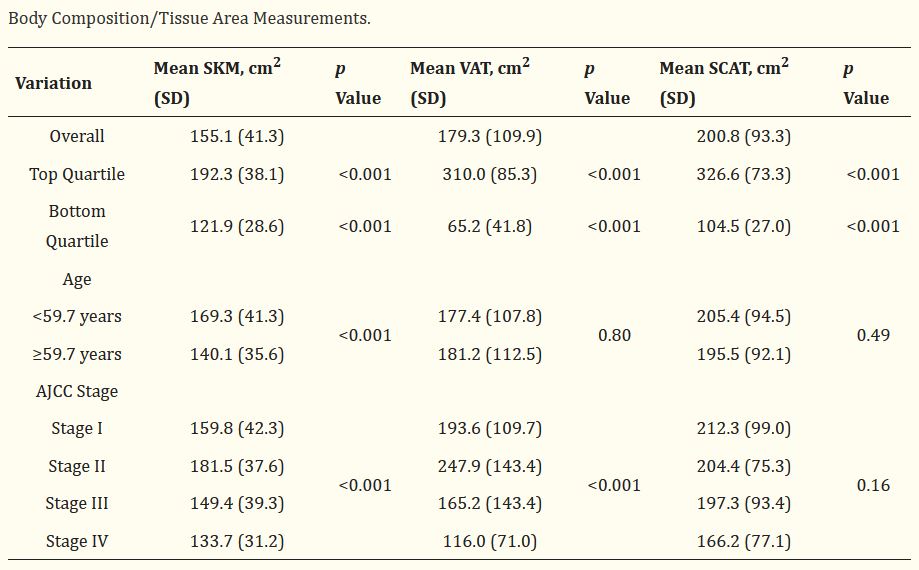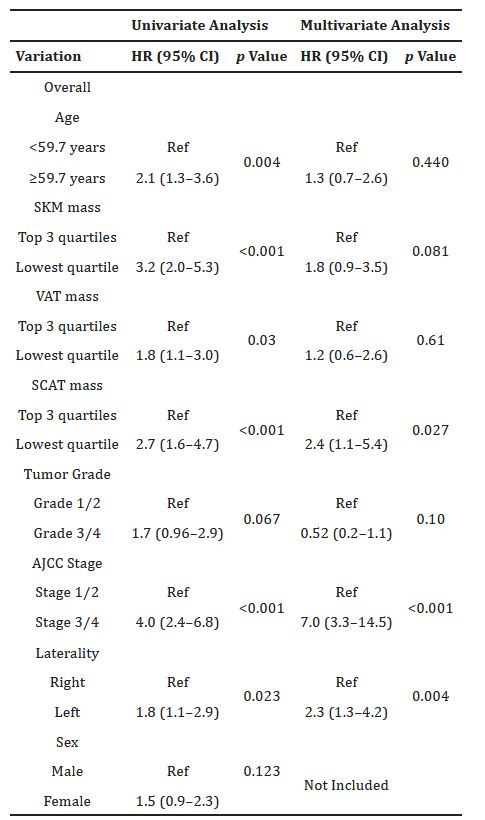The combination of low muscle mass and high tumor IL-6 expression predicts early death in patients with clear cell renal cell carcinoma, according to a new study. As with some other malignancies, cachexia is a major cause of mortality in ccRCC, the authors warned, noting that the combination of low muscle mass and high tumor IL-6 expression should raise alarms.

Click To Enlarge: Abbreviations: SKM = skeletal muscle mass, VAT = visceral adipose tissue mass, SCAT = subcutaneous adipose tissue mass.
Source: Cancers (Basel). 2020 Jun 17;12(6):1605.
INDIANAPOLIS — The most common form of renal cancer and one of the most common cancers of the urinary tract, clear cell renal cell carcinoma (ccRCC) affects almost twice as many men as women. Due in large part to this and other risk factors—age, tobacco smoking, obesity and hypertension—ccRCC disproportionately affects the veteran population. Thus, a better understanding of the disease and factors in survival is a priority for the VA.
Previous research has shown that ccRCC is frequently associated with symptoms of cachexia—a wasting syndrome characterized by a dramatic loss of fat and skeletal muscle mass—which itself is associated with decreased quality of life and poor response to chemotherapy and has been implicated as the cause of death as many as 20% of cancer patients.
A recent study led by researchers at the Indiana University School of Medicine and Richard L. Roudebush VAMC in Indianapolis shows low muscle mass along with high tumor interleukin-6 (IL-6) expression is strongly associated with mortality in ccRCC.
Cachexia is caused in part by the actions of inflammatory cytokines on multiple tissues. Such actions range and include modulating the tumor microenvironment; disrupting hematopoiesis; altering central mechanisms of food intake, basal temperature, activity and energy expenditure; and direct induction of lipolysis, muscle catabolism and bone loss, according to the authors.

Click To Enlarge: Association with All-Cause Mortality.
Abbreviations: SKM = skeletal muscle mass, VAT = visceral adipose tissue mass, SCAT = subcutaneous adipose tissue mass, AJCC = American Joint Commission on Cancer.
Source: Cancers (Basel). 2020 Jun 17;12(6):1605.
To better understand the relationships among body phenotype, tumor gene expression and survival in patients with ccRCC, the researchers turned to the Cancer Imaging Archive and The Cancer Genome Atlas, a national database of patient CT scans, demographic information, tumor gene expression data and disease-specific data.
With data from 217 ccRCC patients, they assessed the association between skeletal muscle mass (SKM), visceral adipose mass (VAT) and subcutaneous adipose mass (SCAT) and overall survival by univariate and multivariate analysis. Patients were divided in to quartiles for each tissue by sex. Male and female quartiles were analyzed individually and combined to evaluate for differences in overall survival. Body composition and overall survival were compared with tumor gene expression of 21 cachexia-associated cytokines.1
Key Findings
- The median overall survival for all patients was 75.2 months. There was no sex-specific difference in overall survival, which was 75.6 months for males and 64.6 months for females.
- Patients in the lowest SKM quartile had significantly shorter overall survival versus the top three SKM quartiles. Patients who fell into the lowest quartiles for VAT and SCAT also demonstrated significantly shorter overall survival.
- Several tumor cytokines correlated with mortality, most strongly IL-6, the study found. High IL-6 expression was associated with significantly decreased survival overall survival compared to high IL-6. The combination of low SKM/high IL-6 was associated with significantly lower overall survival compared to high SKM/low IL-6 expression
“Low skeletal muscle and visceral and subcutaneous adipose masses have a clear and significant association with decreased overall survival in patients with clear cell renal carcinoma,” the authors wrote in the journal Cancers. “These findings support previous studies, agreeing that cachexia is a major cause of mortality in cancer, adding ccRCC to the list of malignancies in which this association has been made.”
The study’s results demonstrate, for the first time, that the combination of low muscle mass and high tumor IL-6 expression is an especially concerning combination that predicts early death in patients with ccRCC, according to the authors.
“Ultimately, once the appropriate tools are available, including automated body composition analysis and reporting of tumor transcriptomics, these factors could be considered when designing a patient care plan and counseling ccRCC patients on prognoses.”
- Kays JK, Koniaris LG, Cooper CA, Pili R, Jiang G, Liu Y, Zimmers TA. The Combination of Low Skeletal Muscle Mass and High Tumor Interleukin-6 Associates with Decreased Survival in Clear Cell Renal Cell Carcinoma. Cancers (Basel). 2020 Jun 17;12(6):1605. doi: 10.3390/cancers12061605. PMID: 32560494; PMCID: PMC7352265.

